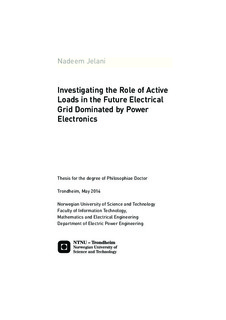| dc.contributor.advisor | Molinas, Marta | nb_NO |
| dc.contributor.author | Jelani, Nadeem | nb_NO |
| dc.date.accessioned | 2014-12-19T13:54:48Z | |
| dc.date.available | 2014-12-19T13:54:48Z | |
| dc.date.created | 2014-05-08 | nb_NO |
| dc.date.issued | 2014 | nb_NO |
| dc.identifier | 716179 | nb_NO |
| dc.identifier.isbn | 978-82-326-0271-1(electronic ver.) | nb_NO |
| dc.identifier.isbn | 978-82-326-0270-4 (printed ver.) | nb_NO |
| dc.identifier.uri | http://hdl.handle.net/11250/257750 | |
| dc.description.abstract | The advancements in power electronics in the past decade have resulted in a wide spread use of power electronically interfaced generation units and loads in both AC and DC distribution systems. Power electronics plays an important role in the modern automotive, sea and under sea and aircraft industry. Moreover, the use of power electronics based motor drives in industrial application has been growing very fast. Depending on the type of regulation, many of these PE interfaces behave as constant power loads (CPLs) for the utility. These power electronic (PE) interfaces can be optimally controlled to provide the bidirectional power flow and can therefore emerge as strong candidates to replace many dedicated devices being utilized for specific grid services.
CPLs are important part of modern power distribution networks and their number will increase in the foreseeable future. In this research program, main focus has been put to use CPLs for transient stability enhancement and fault ride through (FRT) under balanced/unbalanced grid voltage dips instead of employing a dedicated compensating device for such ancillary grid services. Alleviation of harmonics and current distortions caused by the non-linear loads under both ideal and non-ideal voltage conditions has also been investigated in this work using CPLs as active power filters (APF). Simulations are carried out in PSCAD/EMTDC and different models of AC distribution systems with different shares of loads are considered in accordance with specific study.
Transient stability study of the AC distribution system demonstrates that the CPLs can effectively replace the existing compensating devices and provide many ancillary grid services. A large increase in transient stability margins has been observed under balanced grid voltage sags when CPLs provide the ancillary reactive power during the fault and avoid a possible voltage collapse due to excessive reactive power consumption. The ancillary reactive power provision increases the current rating of the CPL converters. However, the increase in the current rating of the distributed CPLs is always less compared to the current rating of a dedicated STATCOM when providing the reactive power during the voltage sag. It has been concluded that the reactive injection by the CPLs improves the terminal voltage by a small amount and hence decreases the total branch current. Therefore, an optimal operating point for a CPL can be established depending on the load power, network impedance and the severity of the grid fault.
FRT enhancement under asymmetrical grid faults using CPLs has been carried out and a modification in the CPL control structure is proposed incorporating the positive and negative sequence voltage extraction. The positive sequence voltage compensation avoids the possible voltage collapse and the rotor does not accelerate beyond the electro-mechanical stability. The negative sequence voltage control removes the torque and power oscillations during the asymmetrical grid fault and improves the life time of the generation system. FRT enhancement by the CPLs increases the current rating of the devices. However, each distributed CPL requires lower current rating compared to one centralized STATCOM when providing FRT enhancement services.
Power quality issues have been addressed in a distribution system under ideal/non-ideal voltage conditions. CPL is used as APF and time domain IRP p-q and frequency domain CPC approach is used to extract the compensating current references in order to eliminate the harmonics in the source current. A positive sequence voltage detector is employed in the CPL control structure under non-ideal voltage conditions. Simulation results for both ideal and non-ideal source voltage conditions indicate that the harmonics in the source currents are removed using both the time and frequency domain approaches. CPC based control algorithm, however, provides slightly better results due to the sequence separation of the compensating current. The natural CPL action further decreases the THD in source current because it adds a fundamental current component in the total source current. | nb_NO |
| dc.language | eng | nb_NO |
| dc.publisher | NTNU | nb_NO |
| dc.relation.ispartofseries | Doctoral Theses at NTNU, 1503-8181; 2014:174 | nb_NO |
| dc.title | Investigating the Role of Active Loads in the Future Electrical Grid Dominated by Power Electronics | nb_NO |
| dc.type | Doctoral thesis | nb_NO |
| dc.source.pagenumber | 170 | nb_NO |
| dc.contributor.department | Norges teknisk-naturvitenskapelige universitet, Fakultet for informasjonsteknologi, matematikk og elektroteknikk, Institutt for elkraftteknikk | nb_NO |
| dc.description.degree | PhD i elkraftteknikk | nb_NO |
| dc.description.degree | PhD in Electric Power Engineering | en_GB |

